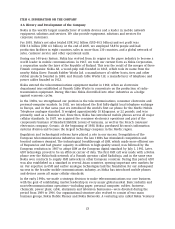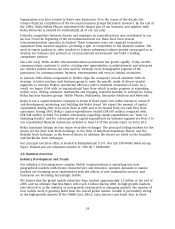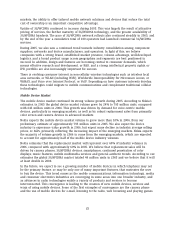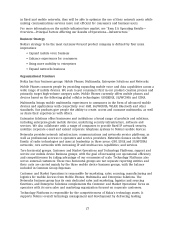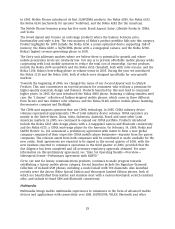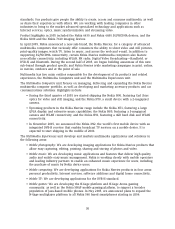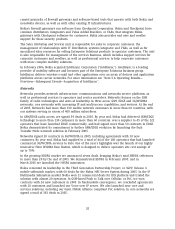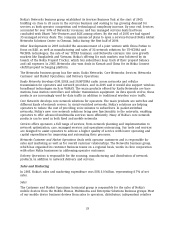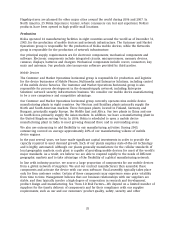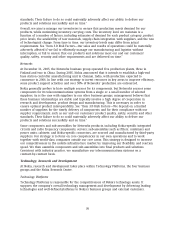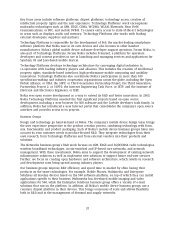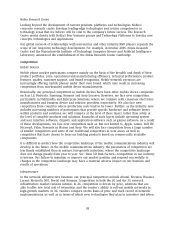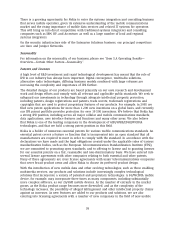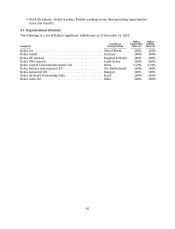Nokia 2005 Annual Report Download - page 34
Download and view the complete annual report
Please find page 34 of the 2005 Nokia annual report below. You can navigate through the pages in the report by either clicking on the pages listed below, or by using the keyword search tool below to find specific information within the annual report.consist primarily of firewall gateways and software-based tools that operate with both Nokia and
non-Nokia devices, as well as with other existing IT infrastructures.
Nokia’s firewall gateways run software from Checkpoint Corporation. Nokia and Checkpoint have
common distributors, integrators and Value Added Resellers, or VARs, that integrate Nokia
gateways with Checkpoint software for customers. Nokia also provides end user and reseller
support for these security products.
The Sales, Marketing and Services unit is responsible for sales to corporate customers, the
management of relationships with IT distributors, systems integrator and VARs, as well as for
specialized sales resources for selling Enterprise Solutions products to operator customers. The unit
is also responsible for management of the services business, which includes support services for
corporate customers and resellers, as well as professional services to help corporate customers
with more complex mobility solutions.
In February 2006, Nokia acquired Intellisync Corporation (‘‘Intellisync’’). Intellisync is a leading
provider of mobility software and becomes part of the Enterprise Solutions business group.
Intellisync delivers wireless e-mail and other applications over an array of devices and application
platforms across carrier networks. For more information see ‘‘Item 5.A Operating Results—
Overview—Subsequent Events—Acquisition of Intellisync’’.
Networks
Networks provides network infrastructure, communications and networks service platforms, as
well as professional services to operators and service providers. Networks focuses on the GSM
family of radio technologies and aims at leadership in three areas: GSM, EDGE and 3G/WCDMA
networks; core networks with increasing IP and multi-access capabilities; and services. At the end
of 2005, Networks had more than 150 mobile network customers in more than 60 countries, with
our systems serving in excess of 400 million subscribers.
In GSM/EDGE radio access, we signed 39 deals in 2005. By year end, Nokia had delivered GSM/EDGE
technology to more than 130 customers in more than 60 countries, was a supplier to 45 of the 121
operators that have launched EDGE commercially, and had signed more than 50 contracts in EDGE.
Nokia demonstrated its commitment to further GSM/EDGE evolution by launching the Dual
Transfer Mode network solution in February 2005.
Networks signed 20 contracts in 3G/WCDMA in 2005, including agreements with 10 new
customers. By year end, Nokia had supplied to a total of 44 of the 100 operators that had launched
commercial 3G/WCDMA services to date. One of the year’s highlights was the launch of our highly
innovative Flexi WCDMA Base Station, which is designed to deliver operators site cost savings of
up to 70%.
In the growing HSDPA market we announced seven deals, bringing Nokia’s total HSDPA references
to more than 20 by the end of 2005. We demonstrated HSUPA in February 2005, and in
March 2005 we launched the I-HSPA innovation.
Nokia cemented its leadership in the Third Generation Partnership Project, or 3GPP, Release 4
mobile softswitch market, with 60 deals for the Nokia MSC Server System during 2005. In the IP
Multimedia Subsystem market Nokia won 11 commercial deals for IMS platform and trialed the
solution with almost 20 operators. In GSM-based Push to Talk over Cellular, or PoC, we won
contracts with 24 new customers in 2005. In fixed-mobile convergence, we concluded agreements
with 10 customers and launched our Voice over IP server. We also launched new core and
services solutions, including our Open Mobile Alliance compliant PoC solution. In core networks we
signed a total of 192 deals in 2005.
32



